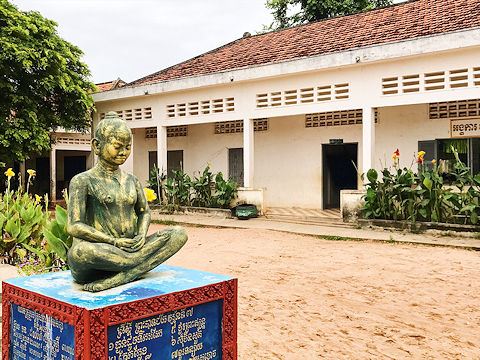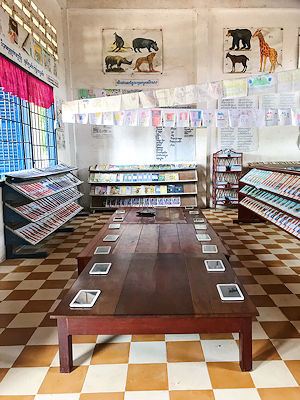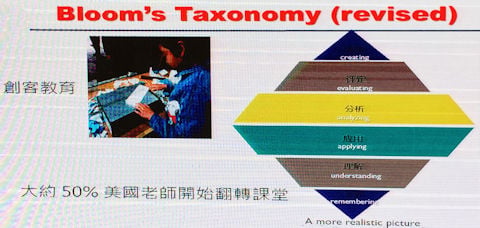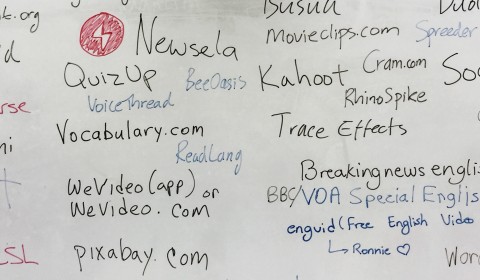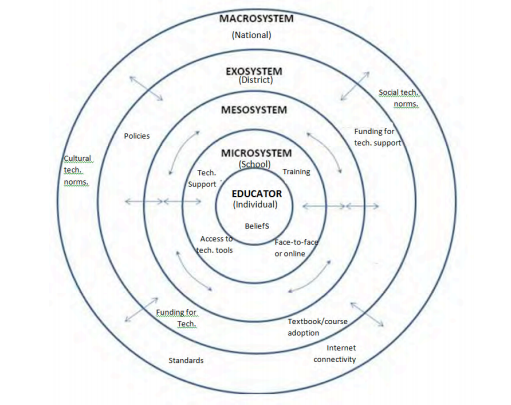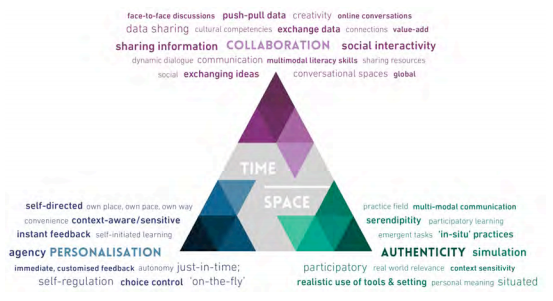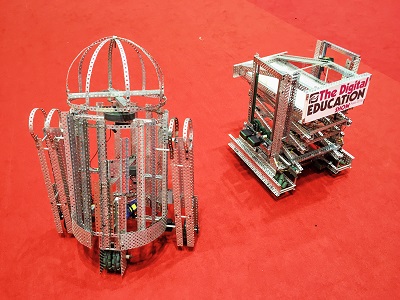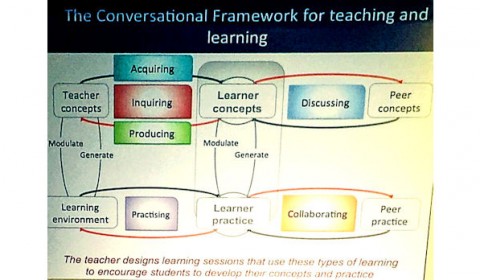EUROCALL Conference
Limassol, Cyprus
24-27 August, 2016

St Raphael Resort, Limassol, Cyprus. Photo by Mark Pegrum, 2016. May be reused under CC BY 3.0 licence.
This year’s annual EUROCALL Conference, focused on the theme of CALL Communities and Culture, took place at the St Raphael Resort in Limassol, Cyprus. With daily temperatures in the mid-30s, delegates made good use of the beaches and swimming pools before and after the conference sessions. In the conference sessions themselves, meanwhile, key themes emerged around the potential for using digital technologies to support learning in areas which to date have in some ways fallen outside of mainstream conversations about language teaching: in the teaching of less widely spoken languages, in the development of digital literacies and 21st century skills, and in the promotion of multiculturalism and even multilingualism. Running through many of the presentations was a strong sense that it’s time for educators to help students make greater use of digital technologies to shape their own learning environments and experiences.
In my opening keynote, Why mobile devices aren’t enough: Learning languages, building communities and exploring cultures, I spoke about the role to be played by educators in drawing our students’ attention explicitly to the potential inherent in their everyday mobile devices, used in their everyday contexts, to support language learning, community building, and cultural and intercultural exploration. While there is clearly a place for social justice projects which make use of basic technologies and traditional pedagogies in under-resourced contexts, it’s interesting to note that many of the most creative of today’s mobile learning initiatives, at least those located in better-resourced settings, combine the learning of languages with the development of digital literacies and 21st century skills, often in multicultural contexts, and sometimes in multilingual contexts. In such initiatives, students produce their own user-generated content which not only supports their own learning, but can support the learning of peers and even wider communities.
In his keynote on the second day, Let’s play with constructionism, Panayiotis Zaphiris from Cyprus University of Technology began by introducing Seymour Paper’s theory of constructionism which, unlike constructivism, is not so much about learning by discussing, but learning by creating and building artefacts. He then went on to outline the newer idea of social constructionism, which adds social components to the original concept of constructionism. Artefacts, he explained, can be physical or digital constructions. Through a series of case studies based in the Cyprus Interaction Lab, he went on to indicate six key elements of implementing social constructionism:
- developing physical learning spaces for constructionist learning
- learners constructing shared/common understanding
- learners playing and having fun
- constructing learners’ communities of interest/practice
- giving learners tools for constructing their knowledge
- involving learners in designing their learning
The last of these elements, he suggested, is the most innovative. He reported on a study entitled Constructionism, Participatory Design and CALL focusing on a course called Learn Greek Online, where people can learn the Greek language without a teacher necessarily being online. The site was developed using participatory design and distributed social constructionism. A set of old audio lessons were posted online without further guiding materials, but the learning community then began to support each other and to create materials: transcribing audio files, correcting each other’s transcriptions, and so on. By 2002, there were 50,000 students; this was a kind of MOOC before MOOCs.
In her keynote on the third day, Deconstructing digital literacy practices: Identity narratives from the South, Leila Kajee explained that digital technologies provide children with alternative platforms to engage in social interaction, and multiple identities are the norm. The South African Cyber Lives project maps digital practices across generations, contexts and communities, looking at how users construct their identities digitally and what the implications are for teaching and learning English. Often children’s out-of-school digital literacy practices are not recognised inside the classroom, but in fact these out-of-school practices have important implications for the classroom. The New Literacy Studies movement focuses our attention on the shifting landscape of home, community, work and schools, and gives us a set of theoretical lenses to examine the interconnection between these. Digital literacies, she went on to say, have many components from access through information analysis to sharing and safety. Drawing on the work of Stuart Hall and Chris Weedon, she explained the postmodern perspective that a person has no single fixed identity, and that history, language and identity are intertwined. She gave a range of examples of how ordinary individuals are using social media platforms to construct identities, to engage socially, and to develop a voice under sometimes difficult circumstances.
She then looked at three examples of young learners’ use of digital technologies. Firstly, she talked about the use of the children’s game Moshi Monsters by a young girl, Eva, who created a story around her reality and cyberreality, embodying her chosen persona through an avatar, while also creating a second, male avatar. Secondly, she showed a digital video narrative by Khutso, a second language speaker of English, explaining his journey to becoming a teacher; he constructed an identity as poverty-stricken and wearing a mask to school, before reaching a turning point – inspirational teachers – who made him want to become a change agent himself. In another digital video narrative by Watkins, who also chose to become a teacher, the narrator began by characterising himself as a rebel before reaching a Eureka moment when he realised that he himself could be the change he wanted to see in wider society. Thirdly, she discussed a girl, Cassie, who used Facebook as a way of establishing her diasporic identity, having moved from the Democratic Republic of the Congo to South Africa, through mechanisms such as selfies and wall posts, where she sought to establish her own voice.
Exploring digital literacies with students in school, she said, can be a way of reimagining opportunities for connections across institutional and community contexts, and providing permeable boundaries between home and school. In the process, students can develop voice and identity. It is important, she concluded, to reimagine opportunities for identity construction across contexts.
In the first series of parallel sessions, I chaired a strand in which presenters outlined the use of digital technologies in teaching a variety of less commonly taught languages. It was intriguing and inspiring to hear about the uses of new technologies to support languages which, because of smaller numbers of speakers and/or learners, are much less well-resourced than more widely spoken languages.
In her paper, CALL and less commonly taught languages – Still a way to go, Monica Ward spoke about the fact that there is still a distance to go before new technologies become normalised in the practice of teachers of less commonly taught languages (some of which may be quite widely spoken, but not so commonly taught in some geographical areas). Using the examples of Arabic, Irish and Nawat (from El Salvador), she outlined issues with the kinds of access pathways students may have into potential language learning materials. Teachers should learn from others’ practices, and can pick and choose among the options, starting with the ‘low-hanging fruit’, that is, widely available and relatively simple tools that we know to work well.
In their paper, Teaching Turkish in low-tech contexts: Opportunities and challenges, Katerina Antoniou and Antigoni Parmaxi spoke about teaching Turkish in Cyprus, where they introduced Kahoot, with students using internet-connected computers and answers displayed via a projector (since mobile devices could not be used due to a lack of wifi). This allowed all students, who were of different ages, to participate. Students were motivated and involved, and were willing to discuss their answers with the group. At the beginning, however, the adult students thought Kahoot was just a game which was a waste of their time, but over time they came to see its benefits. While older students could help younger students with language, the roles were reversed when it came to helping with technology. Challenges, the presenters suggested, can be opportunities when diverse skills, interests, motivations, goals and abilities complement each other. Despite the challenges, they concluded, a low-tech context can still offer more opportunities than a no-tech context.
In his presentation, A platform and customization toolkit for error-tolerant search of language resources, Anton Rytting described the need for a platform that allows language learners to search for words they have heard in an error-tolerant context so that they can find what they are looking for, even if they have misheard sounds or if they miswrite words. He showcased a ‘Did You Mean’ (DYM) system for a language called Dhivehi, spoken in the Maldives, where possible dictionary entries can be displayed based on their closeness of fit with the word typed by the student. To make such a system, you need a dictionary, a query alphabet, an error model (based on the mistakes you think learners are likely to make), and a way of testing it based on likely queries. There is a DYM Toolkit available, created by researchers at the University of Maryland, that teachers and others can use to create such error-tolerant platforms for different language learners.
In his presentation, An audio-lexicon Spanish-Nahuatl: Using technology to promote and disseminate a native Mexican language, Aurelio López-López described the ALEN application that allows users to enter a word in Nahuatl or Spanish to hear the pronunciation of the word, and to see an illustrative image. The overall goal is to safeguard engendered languages, including by taking advantage of mobile devices which are widely used by young people.
Dealing in some ways with the opposite end of the spectrum, Jack Burston gave a paper entitled The contribution of CALL to advanced level foreign/second language instruction, in which he showed that there have been remarkably few publications in CALL journals about advanced-level instruction using technology. It is notable that advanced-level language barely rates a mention in the published CALL literature, and this research is very limited in terms of the L2 studied, with English the centre of attention followed distantly by German and French. There are four times as many studies about written language as about speaking/listening skills. Above all, these studies are vague about what an advanced level is, and the difficulty of the tasks students are required to undertake. To date, he concluded, CALL has contributed very little to our understanding or practice of advanced foreign/second language instruction. On the positive side, there is great scope for SLA research at the advanced level, with more methodological rigour needed where ‘advanced’ is defined and substantiated; there is a need for a focus on oral as well as written language; and there is room for considering innovative CALL applications such as mobile and/or cloud-based projects.
Another conference theme was digital literacies and 21st century skills seen as an accompaniment to language learning. In their presentation, Preparing Japanese students’ digital literacy for study abroad: How much CALL training is needed?, Travis Cote and Brett Milliner noted that previous research suggests Japanese first year university students lack core computer literacy skills. In surveys, they found that Japanese students assessed their own computer literacy skills as low. Ultimately, the presenters suggested, the students’ lack of ability to use productivity tools is preventing them from using computers effectively for critical thinking and problem solving, since students need to spend time focusing on using the technology itself rather than what the technology should enable them to do. Although smartphone ownership is at 100%, students tend to use these devices only for social and entertainment functions. In the future the presenters plan to encourage blogging to help students develop a range of skills including typing, composition and manipulation of images; provide opportunities to participate in online discussions; provide opportunities that incorporate presentation software; and introduce students to cloud computing as a way to expose them to collaboration.
In their follow-up paper, Tertiary EFL teachers’ digital literacy: Is CALL training still needed?, Brett Milliner, Travis Cote and Ethel Ogane reported on a study of 42 faculty members teaching English at Tamagawa University in Japan, conducted in order to determine their digital literacy levels, whether they could benefit from extra training, and whether they could lead students in using computers for CALL purposes. Teachers were relatively modest in their self-assessment of digital knowledge and skills. Most teachers said they enjoyed using computers and felt comfortable doing so, but also wanted to learn more about computers. Teachers thus believe in the use of digital technologies in the classroom and are open to further professional development in this area. Interestingly, they had often acquired their knowledge and skills independently or through peer-to-peer learning.
In her presentation, Digital literacies for language learning and teaching: Developing a national framework, Françoise Blin reported on a six-institution, nationally funded Irish project, led by the University of Limerick, with two major aims: to develop a national framework for digital literacies for language learning and teaching, and to curate and create a wide range of OERs accessible via an online portal. The first aim focuses on the intertwined strands of language skills and practice; digital literacies; and transitions and contexts. In time, all language courses in Ireland should contain learning outcomes for digital literacies within their descriptors. It is important that there is sustainability of e-learning – it has to meet the needs of present and future teachers and learners – as well as sustainability and normalisation of CALL. Surveys to date have revealed that students feel the need to acquire more digital literacies than are currently covered in their courses, while teachers feel that they are lacking in some digital literacies that their students might need them to teach.
Another strong theme of the conference focused on multilingualism and multiculturalism. In her talk, Multilingual CALL – The good, the bad, and the ugly, from the perspective of teacher training students, Judith Buendgens-Kostens suggested that multilingual CALL could involve participants using all the languages to which they have access, ranging from their native languages through to languages in which they might know only a few words. She spoke about the Erasmus project MElang-E, which takes the form of a serious game where players follow the progress of a young musician across Europe as he seeks to convince former bandmates to join in a music competition. Players are faced with a series of communicative situations in which they can make choices about what languages, or combinations of languages, to use in response to interlocutors. There are also many codeswitching situations presented to players, where they can see similarities and differences between languages. In reporting on students’ reactions to this game, she noted that there is much greater acceptance of widely spoken and taught languages, while there is little appreciation of languages that do not have an obvious market value, though they might in fact have other kinds of value in terms of identity or simply enjoyment. The question is whether stakeholders can be convinced that there is a role for this kind of multilingual game in education.
In their talk, Promoting multilingual communicative competence through multimodal academic learning situations, Anna Kyppö and Teija Natri reported on an interdisciplinary course of multilingual interaction piloted at the University of Jyväskylä Language Centre, focusing on the students’ effective use of their own linguistic repertoires and the enhancement of their agency in multilingual and multicultural settings. The learning environment was a combination of a face-to-face classroom, a web-based platform called Optima, and an educational mobile platform called REAL, all used within a task-based framework where language was the instrument for completing tasks (and students were free to use any languages at their disposal). Students’ multilingual and multicultural awareness grew, they were able to adopt skills for their future working lives, and they came to see their peers as learning resources. In the future, the presenters plan to introduce more multilingual and multimodal courses into subject study, to enhance students’ focus on successful communication rather than accurate language use, to more efficiently employ social media and multimodal interactive online resources, and to employ PLEs (personal learning environments).
In her paper, Preparing students’ mobility through telecollaboration: The I-Tell project, Catherine Jeanneau explained that the better prepared students are for experiences abroad, the more they will gain from the experiences. Students need practical advice, linguistic development, intercultural competence, self-awareness and learner autonomy; and there has been a suggestion that the preparation should be more formative than informative (Gutierrez, Duran & Beltran, 2015). The I-Tell project aimed to develop participants’ intercultural, linguistic and digital skills. Volunteer Irish and Spanish students were paired the semester before they went abroad. Over 8 weeks they completed one task per fortnight, using asynchronous and synchronous modes, multimodal communication, and 50% Spanish and 50% English; for example, they were asked to co-design a document giving advice to students going abroad for study. Students were generally positive about the project, but found that time was an issue. The technological platforms were not dictated to students, who chose to use a mixture of tools including email, VoiceThread, Skype, Facebook, Google+, WhatsApp, Instagram and FaceTime; social media in general were seen as authentic channels of communication. Students identified both similarities and differences between the cultures, and generally obtained a broader perspective on the other culture. They reported developing different language skills with the help of peer learning and peer correction. Students engaged in an exchange of practical information, but there was also a lot of psychological preparation involving emotional support. Lessons learnt include the importance of facilitators who can keep the project moving, getting the timing right, setting collaborative tasks, and considering the developmental needs of students.
A whole range of tool types, platforms, and approaches were mentioned in the presentations. Covering a popular tool in his talk, Quizlet: What the students think – A qualitative data analysis, Bruce Lander mentioned that the use of Quizlet has grown dramatically in recent years, with a number of well-known competitors now also on the market, including the recently popular Kahoot. He reported on a study involving text mining of Japanese students’ comments about Quizlet, showing that they were generally very positive about the vocabulary learning possible through Quizlet. He concluded by mentioning Mark Warschauer’s three main reasons for using technology in education – improving academic achievement, facilitating new kinds of learning, and promoting social equity – and linking these to Puentedura’s SAMR model. He wrapped up with a demonstration of Quizlet Live, suggesting that it can be a great tool to engage students in team competitions in the classroom.
In his presentation, Podcasting in a mobile world: Power, potential and pitfalls, Jaime Selwood, the producer of the English News Weekly and the lower-level English News Monthly podcasts, mentioned that there are now 130,000 English language podcasts available in iTunes, with the Chinese language in second place. Beyond the release of the iPod itself, he said, major game changers for podcasting have been the release of smartphones and the expansion of the mobile internet. He mentioned two key ways in which he uses podcasts with his university level English learners in Japan: as out-of-class assignments 4-6 times a semester where students complete podcast activities and later report back to the class; and as part of a podcast creation course where students make and publish 4 podcasts a semester, having recorded, written and edited all the materials themselves. In a student survey, 83% said they liked using podcasts in the first way, mainly because they had choices about which podcasts to listen to; and 77% liked the second way, again mentioning the freedom to choose their own topics.
In his talk, Enhanced tools for CLIL and Clil4U, Kent Andersen outlined an EU project which has developed a pool of resources to support CLIL, now publicly available on the Clil4U website. He then went on to describe another project, Improved Safety for Electricians, where there is an inbuilt CLIL element, allowing users to quickly and easily click on words in the English instructions for automated translations into many other languages. Teachers are able to make use of the Clilstore resource to develop their own materials of this kind. He suggested that to develop the CLIL element more fully, it is important to also build in exercises for students, and this functionality should eventually be added into Clilstore.
In her presentation, Urban explorations for language learning: A gamified approach to teaching Italian in a university context, Koula Charitonos outlined a pervasive and gamified approach to language teaching and learning. She described an Italian language learning game called ImparApp, created with the TaleBlazer authoring tool from MIT, and developed at Coventry University. There are gamified fictional narratives which involve participants in mixed reality, location-based quests using mobile devices in real-world settings. Players can interact with virtual characters, objects and data. In a pilot study, it was found that students thought this was a good orientation activity, permitting incidental learning and helping them learn about history. There were also challenges, such as students focusing mainly on finding the next location and not interacting with each other, with risks to health and safety as students focused on devices rather than their environment. Students also suggested incorporating more visuals, zoomable maps, and Italian background music, as well as ways of facilitating social interaction.
In his paper, Mobile-assisted language learning and language learner autonomy, Paul Lyddon spoke about the importance of learner autonomy – that is, the right to self-determination, or the “capacity to take control of one’s own learning” (Benson, 2011) – to support lifelong learning. He suggested that there are potential areas of interface between mobile technologies and autonomy: mobile devices allow learning anytime and anywhere; are conduits to rich, multimodal content; and are extensions of our mental and physical faculties in areas like observation, recall, research and communication. He went on to note that there is an incongruence between learner training courses which help students to develop independent goal setting, and to apply that know-how in informal learning contexts and, on the other hand, traditional formal learning contexts with course and programme standards, where times and places are administratively decided, and where there are classroom policies to prevent off-task behaviour. This dramatically constrains the versatility of the devices. In formal settings, students may have the ability and the possibility, but often not the permission, to use their devices as they wish to support their learning. He suggested that we could consider moving towards a model of socially responsible learner autonomy, where students fulfil the requirements of a course in terms of enrolment and assignment completion, with different degrees of autonomy being possible in the process of carrying out course tasks. To remediate the current situation, he concluded, we should explicitly acknowledge the limited nature of autonomy in formal learning contexts; inculcate expectations of learner characteristics aimed at helping students to fulfil assignment requirements in personally meaningful ways; and foster new forms of self-awareness and self-discipline to enable mobile devices to be deployed effectively to support greater autonomy.

The Mediterranean, Limassol, Cyprus. Photo by Mark Pegrum, 2016. May be reused under CC BY 3.0 licence.
The last day of the conference wrapped up with a roundtable hosted by Mirjam Hauck, where a number of presenters were asked our opinions on the takeaway messages of the conference. For me, the first takeaway message concerns a changing sense of CALL, which is now extending into areas like lesser-taught languages, digital literacies and 21st century skills, and multilingualism and multiculturalism. This makes CALL as a concept somewhat more amorphous and diffuse, but simultaneously richer, as teachers and researchers who may not traditionally have been part of CALL conversations are drawn into our discussions.
My second takeaway message concerns differences between the CALL conversations (and more general educational technology conversations) in Asia and Europe. Much of the time, I attend and present at conferences in the Asian region, and it is striking to see how different the tone of the conversation is in the European region. In the latter case, there would generally seem to be a more widespread acceptance of the benefits of multilingualism and codeswitching as opposed to immersive target language learning, of communicative competence as opposed to linguistic accuracy, and of student input into learning designs as opposed to the mandating of learning content by ministries of education, institutions or teachers. At the same time, there are important pedagogical and technological developments taking place in Asia, perhaps most notably in the area of contextualisation of learning as a way of dealing with issues around transfer distance, as seen in the development of large, often state- or ministry-backed mobile augmented reality learning projects – but most of these projects seem to be almost unheard-of in Europe. There is clearly much to be gained from more conversation between European and Asian teachers and researchers about the most promising directions for future technology-enhanced language learning.
